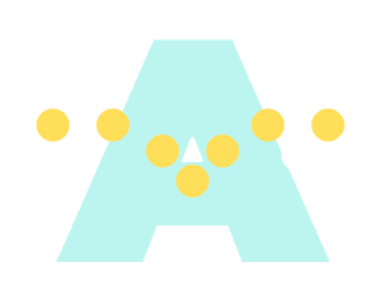Praxis II: Mooring at the Toronto Sailing and Canoe Club
For all those engineering students wondering what it means to be an engineer.
Aarya Shah
5/30/20255 min read
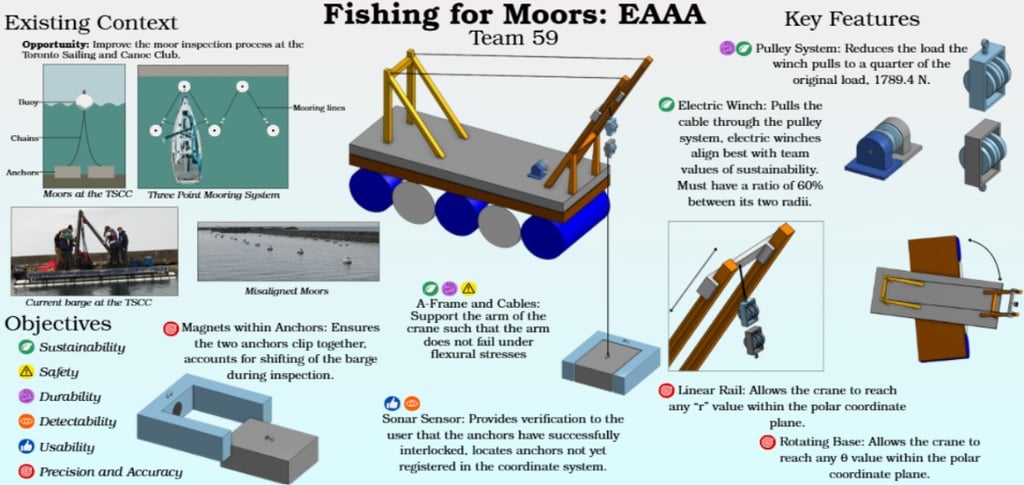

Engineering is more than just calculus and physics, or else what would make us different than the mathematicians or the physicists; Engineering is about the application of theory and principles to solve problems.
In my first year of undergrad, I took two courses: Praxis I and Praxis II, otherwise known as Engineering Design courses. While most individuals dread this course due to the immense workloads and the harsh marking, I appreciated the many valuable skills and opportunities it provided me. While Praxis I provided us with a strong foundation, the real-life application in Praxis II helped me develop my position and values as a student engineer. Here, I will summarize my Praxis II project working with the Toronto Sailing and Canoe Club.
What Problems are Worth Solving?
In praxis II, all teams must submit a Request For Proposal (RFP); 8 RFPs get chosen every year by our professors and student representatives. The chosen RFPs are then brought forward to the class, to which each team choses one RFP to focus on for the remainder of the semester.
Among the chosen RFPs, our team decided to focus on "Mooring at the Toronto Sailing and Canoe Club" which would allow us to solve the problem of misaligned mooring spaces at the TSCC due to improper inspections and 'orphan anchors'. Our team valued novelty and ambition, and we wanted a project that would pique our curiosity and allow for the most personal growth. So while none of us knew what mooring was, we decided to focus on this RFP.
This taught me that the problems worth solving are the ones that hold personal value and interest, while benefitting society. Throughout an engineering journey, there are often times when you have to choose your battles, and establishing your position and values were integral for us to choose wisely.
Framing Our Opportunity
Working with a community can sometimes be more challenging that you think — you must consider the lived experience of your community. Sometimes these cannot be seen or assessed, and thus creating requirements or understanding an opportunity become much more difficult.
Our team embraced this challenge by doing secondary research on moors and the sailing community, listening to sailors and meeting with the TSCC to understand their concerns.
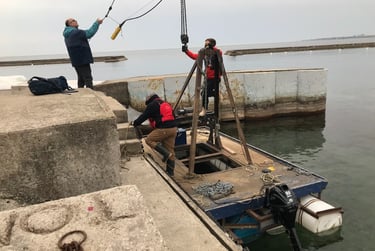

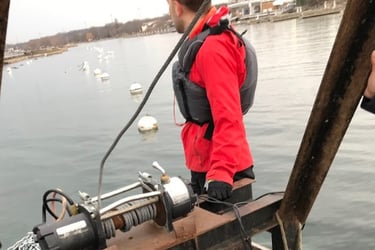

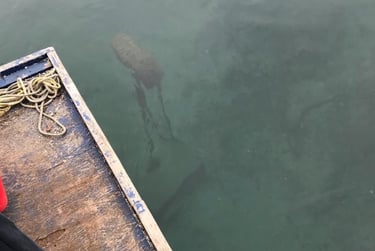

We realized that the community prioritized sustainability and planned to invest in a new and improved barge for the future. Additionally, we noted that the TSCC used a 3-point mooring system and had a capacity of 95 sailboats. Their inspections were often done using a barge (seen on far left) and the water was often quite turbid. Most of their inspection and repositioning of the moors was done by "eye-balling" the placement, which we interpreted could be a cause for misalignment. Many of these observations served as the basis for our requirements framework.
Consequently, our goal was to design for:
Sustainability
Safety
Durability
Detectability
Precision and Accuracy
Introducing the EAAA
Our final product was the EAAA: The Enhanced Autonomous Anchor Arm; it was an autonomous barge system which could turn user-inputted Cartesian coordinates into polar coordinates corresponding to how much the barge must rotate or extend/ retract its arm to accurately place the concrete anchor blocks in its precise position. We incorporated support and cables that would allow for an equal distribution of weight throughout the barge, and a four-point pulley system as it could alleviate 25% of the load the electric winch would have to carry.
Additionally, to solve the problem of misaligned moors, we realized we would need to have a reference marker in the lakebed that we could refer to when inspecting the moors and returning them to their intended positions. Our first instinct was to place sensors in the lakebed that could signal their locations. However, it would be a hassle to inspect the sensors, place them in accurate positions and retrieve them.
During the community visit, we noted that the TSCC had 2 concrete anchors that would support the buoy. We altered the shape of these blocks so they could fit together like puzzle pieces, acting like 'sister anchors' to each other when one was being inspected. This would be a more sustainable way to use our available resources while effectively solving the problem.
As a self-correcting measure, we implemented magnets on these concrete blocks and sonar sensors on the bottom of the barge that would realign the anchors during an error and provide metric feedback about correct positioning of the anchors respectively.
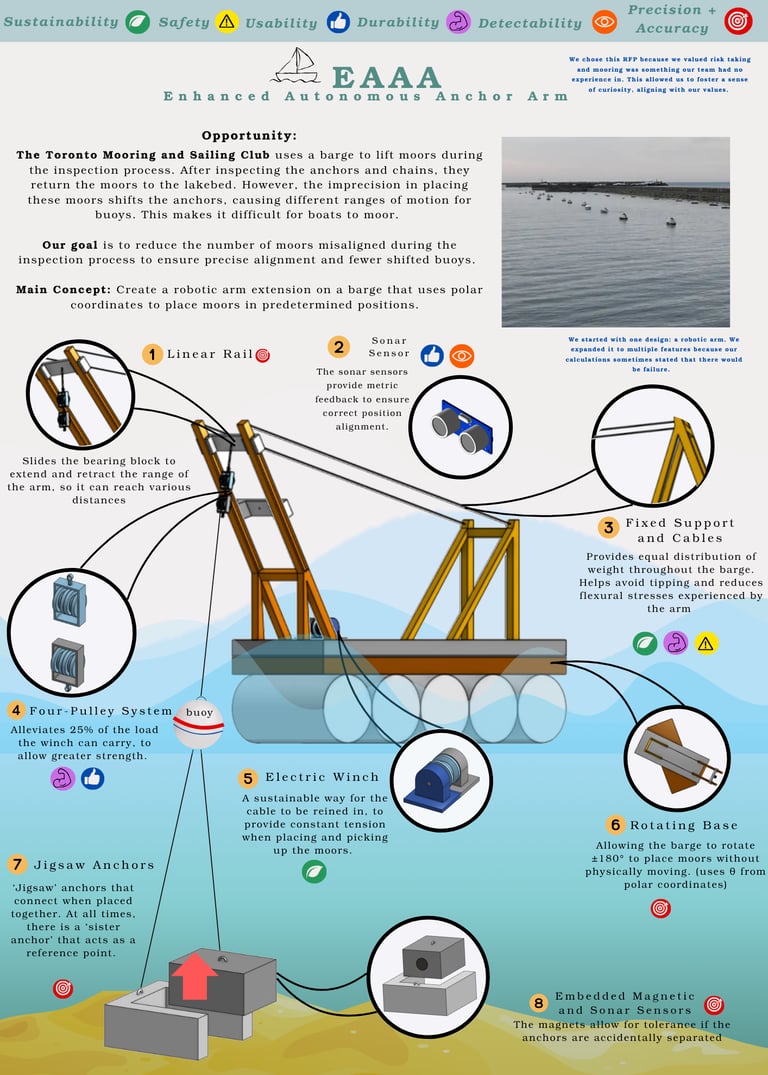

A one-pager we created to detail our product and its main features to solve the opportunity.
A Deep Dive into Diverging
Coming up with this final idea was no easy task. We spent countless hours in front of a whiteboard diverging and converging on ideas, using techniques like Brainwriting 4-3-3, Random Input, SCAMPER and Challenge Assumptions (seen below).
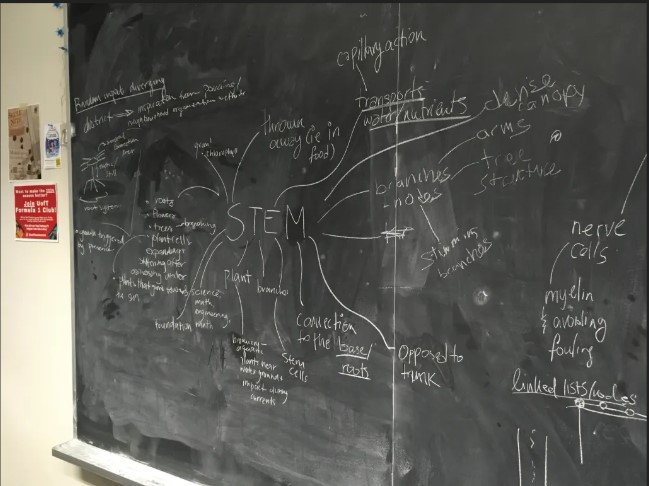

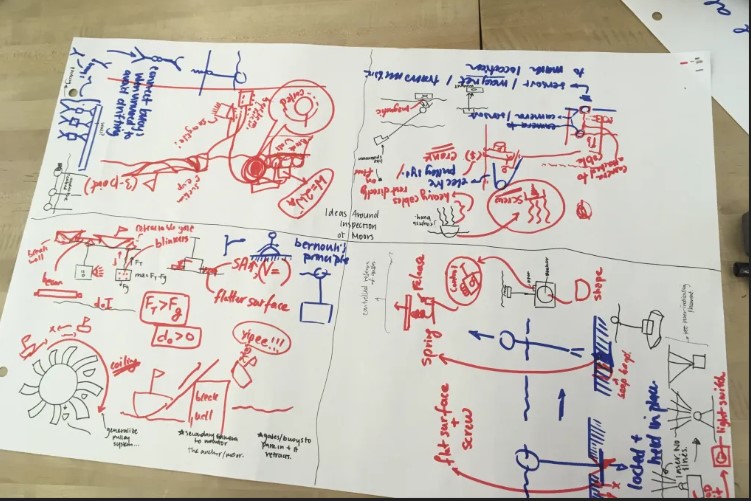

Collaboratively generating ideas through diverging methods we were taught in this course.
We converged on three final designs that we presented during a Beta Release, all addressing the problem in different ways: a sun dock which can create a set amount of 'parking spots' for boats, a robotic arm that can precisely place the concrete blocks in place and a sensor that can autonomously conduct the inspection process, thereby eliminating the need for the concrete blocks to be pulled out of the water for investigation. We chose these prototypes because they were unique and combined many of the smaller ideas we had generated.
When the time came to narrow down to our final design, we used a similar technique of combining features we liked into a prototype we valued the most. We chose the robotic arm because we felt it was the most feasible and aligned with the goals of the community and ourselves. However, as we furter investigated, we realized that the robotic arm had limitations of its own that would need to be accounted for. As we kept on finding more limitations, we had to reconnect with the whiteboard and find novel solutions.
What started as a simple concept soon became a complex design with multiple variables and calculations to justify our decisions. It is important to never underestimate the severity of the problem that you are dealing with.
So why did you not implement this design?
When presenting our idea during showcase, the final project of the semester, we noted that a key next step would be building this product on a larger scale. However, this would be far more complicated, costly and impractical given that the 3D-printed prototypes were merely models we created. While mathematical models and the physics equations we used are a great stepping stone for an estimate, they cannot accurately predict the best designs or whether this barge would work on a larger scale.
This project taught me valuable skills ranging from decision-making, problem-solving, innovative thinking to working with a team to apply theory into reality. I came out with experience on building and proposing designs and learnt the complexities of models when trying to replicate them to a real-life scenario on a much larger scale. I realized that sometimes, the simplest ideas are often the best ones because they are much quicker to test and implement.
